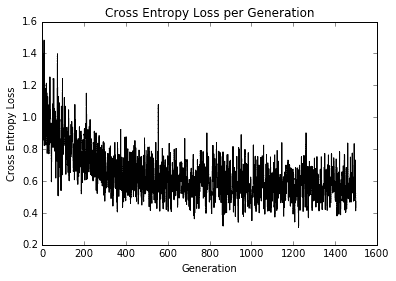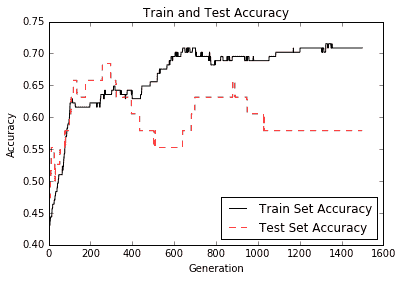# 實現邏輯回歸
對于這個秘籍,我們將實現邏輯回歸來預測樣本人群中低出生體重的概率。
## 做好準備
邏輯回歸是將線性回歸轉換為二元分類的一種方法。這是通過將線性輸出轉換為 Sigmoid 函數來實現的,該函數將輸出在 0 和 1 之間進行縮放。目標是零或一,表示數據點是在一個類還是另一個類中。由于我們預測 0 和 1 之間的數字,如果預測高于指定的截止值,則預測被分類為類值 1,否則分類為 0。出于此示例的目的,我們將指定 cutoff 為 0.5,這將使分類像舍入輸出一樣簡單。
我們將用于此示例的數據將是從作者的 GitHub 倉庫獲得的低出生體重數據( [https://github.com/nfmcclure/tensorflow_cookbook/raw/master/01_Introduction/07_Working_with_Data_Sources/birthweight_data/birthweight.dat](https://github.com/nfmcclure/tensorflow_cookbook/raw/master/01_Introduction/07_Working_with_Data_Sources/birthweight_data/birthweight.dat) )。我們將從其他幾個因素預測低出生體重。
## 操作步驟
我們按如下方式處理秘籍:
1. 我們首先加載庫,包括`request`庫,因為我們將通過超鏈接訪問低出生體重數據。我們還發起了一個會議:
```py
import matplotlib.pyplot as plt
import numpy as np
import tensorflow as tf
import requests
from sklearn import datasets
from sklearn.preprocessing import normalize
from tensorflow.python.framework import ops
ops.reset_default_graph()
sess = tf.Session()
```
1. 接下來,我們通過請求模塊加載數據并指定我們要使用的特征。我們必須具體,因為一個特征是實際出生體重,我們不想用它來預測出生體重是大于還是小于特定量。我們也不想將 ID 列用作預測器:
```py
birth_weight_file = 'birth_weight.csv'
# Download data and create data file if file does not exist in current directory
if not os.path.exists(birth_weight_file):
birthdata_url = 'https://github.com/nfmcclure/tensorflow_cookbook/raw/master/01_Introduction/07_Working_with_Data_Sources/birthweight_data/birthweight.dat'
birth_file = requests.get(birthdata_url)
birth_data = birth_file.text.split('\r\n')
birth_header = birth_data[0].split('\t')
birth_data = [[float(x) for x in y.split('\t') if len(x)>=1] for y in birth_data[1:] if len(y)>=1]
with open(birth_weight_file, 'w', newline='') as f:
writer = csv.writer(f)
writer.writerow(birth_header)
writer.writerows(birth_data)
# Read birth weight data into memory
birth_data = []
with open(birth_weight_file, newline='') as csvfile:
csv_reader = csv.reader(csvfile)
birth_header = next(csv_reader)
for row in csv_reader:
birth_data.append(row)
birth_data = [[float(x) for x in row] for row in birth_data]
# Pull out target variable
y_vals = np.array([x[0] for x in birth_data])
# Pull out predictor variables (not id, not target, and not birthweight)
x_vals = np.array([x[1:8] for x in birth_data])
```
1. 首先,我們將數據集拆分為測試和訓練集:
```py
train_indices = np.random.choice(len(x_vals), round(len(x_vals)*0.8), replace=False)
test_indices = np.array(list(set(range(len(x_vals))) - set(train_indices)))
x_vals_train = x_vals[train_indices]
x_vals_test = x_vals[test_indices]
y_vals_train = y_vals[train_indices]
y_vals_test = y_vals[test_indices]
```
1. 當特征在 0 和 1 之間縮放(最小 - 最大縮放)時,邏輯回歸收斂效果更好。那么,接下來我們將擴展每個特征:
```py
def normalize_cols(m, col_min=np.array([None]), col_max=np.array([None])):
if not col_min[0]:
col_min = m.min(axis=0)
if not col_max[0]:
col_max = m.max(axis=0)
return (m-col_min) / (col_max - col_min), col_min, col_max
x_vals_train, train_min, train_max = np.nan_to_num(normalize_cols(x_vals_train))
x_vals_test = np.nan_to_num(normalize_cols(x_vals_test, train_min, train_max))
```
> 請注意,在縮放數據集之前,我們將數據集拆分為 train 和 test。這是一個重要的區別。我們希望確保測試集完全不影響訓練集。如果我們在分裂之前縮放整個集合,那么我們不能保證它們不會相互影響。我們確保從訓練組中保存縮放以縮放測試集。
1. 接下來,我們聲明批量大小,占位符,變量和邏輯模型。我們不將輸出包裝在 sigmoid 中,因為該操作內置于 loss 函數中。另請注意,每次觀察都有七個輸入特征,因此`x_data`占位符的大小為`[None, 7]`。
```py
batch_size = 25
x_data = tf.placeholder(shape=[None, 7], dtype=tf.float32)
y_target = tf.placeholder(shape=[None, 1], dtype=tf.float32)
A = tf.Variable(tf.random_normal(shape=[7,1]))
b = tf.Variable(tf.random_normal(shape=[1,1]))
model_output = tf.add(tf.matmul(x_data, A), b)
```
1. 現在,我們聲明我們的損失函數,它具有 sigmoid 函數,初始化我們的變量,并聲明我們的優化函數:
```py
loss = tf.reduce_mean(tf.nn.sigmoid_cross_entropy_with_logits(model_output, y_target))
init = tf.global_variables_initializer()
sess.run(init)
my_opt = tf.train.GradientDescentOptimizer(0.01)
train_step = my_opt.minimize(loss)
```
1. 在記錄損失函數的同時,我們還希望在訓練和測試集上記錄分類準確率。因此,我們將創建一個預測函數,返回任何大小的批量的準確率:
```py
prediction = tf.round(tf.sigmoid(model_output))
predictions_correct = tf.cast(tf.equal(prediction, y_target), tf.float32)
accuracy = tf.reduce_mean(predictions_correct)
```
1. 現在,我們可以開始我們的訓練循環并記錄損失和準確率:
```py
loss_vec = []
train_acc = []
test_acc = []
for i in range(1500):
rand_index = np.random.choice(len(x_vals_train), size=batch_size)
rand_x = x_vals_train[rand_index]
rand_y = np.transpose([y_vals_train[rand_index]])
sess.run(train_step, feed_dict={x_data: rand_x, y_target: rand_y})
temp_loss = sess.run(loss, feed_dict={x_data: rand_x, y_target: rand_y})
loss_vec.append(temp_loss)
temp_acc_train = sess.run(accuracy, feed_dict={x_data: x_vals_train, y_target: np.transpose([y_vals_train])})
train_acc.append(temp_acc_train)
temp_acc_test = sess.run(accuracy, feed_dict={x_data: x_vals_test, y_target: np.transpose([y_vals_test])})
test_acc.append(temp_acc_test)
```
1. 以下是查看損失和準確率圖的代碼:
```py
plt.plot(loss_vec, 'k-')
plt.title('Cross' Entropy Loss per Generation')
plt.xlabel('Generation')
plt.ylabel('Cross' Entropy Loss')
plt.show()
plt.plot(train_acc, 'k-', label='Train Set Accuracy')
plt.plot(test_acc, 'r--', label='Test Set Accuracy')
plt.title('Train and Test Accuracy')
plt.xlabel('Generation')
plt.ylabel('Accuracy')
plt.legend(loc='lower right')
plt.show()
```
## 工作原理
這是迭代和訓練和測試精度的損失。由于數據集僅為 189 次觀測,因此隨著數據集的隨機分裂,訓練和測試精度圖將發生變化。第一個數字是交叉熵損失:

圖 11:在 1,500 次迭代過程中繪制的交叉熵損失
第二個圖顯示了訓練和測試裝置的準確率:
Figure 12: Test and train set accuracy plotted over 1,500 generations
- TensorFlow 入門
- 介紹
- TensorFlow 如何工作
- 聲明變量和張量
- 使用占位符和變量
- 使用矩陣
- 聲明操作符
- 實現激活函數
- 使用數據源
- 其他資源
- TensorFlow 的方式
- 介紹
- 計算圖中的操作
- 對嵌套操作分層
- 使用多個層
- 實現損失函數
- 實現反向傳播
- 使用批量和隨機訓練
- 把所有東西結合在一起
- 評估模型
- 線性回歸
- 介紹
- 使用矩陣逆方法
- 實現分解方法
- 學習 TensorFlow 線性回歸方法
- 理解線性回歸中的損失函數
- 實現 deming 回歸
- 實現套索和嶺回歸
- 實現彈性網絡回歸
- 實現邏輯回歸
- 支持向量機
- 介紹
- 使用線性 SVM
- 簡化為線性回歸
- 在 TensorFlow 中使用內核
- 實現非線性 SVM
- 實現多類 SVM
- 最近鄰方法
- 介紹
- 使用最近鄰
- 使用基于文本的距離
- 使用混合距離函數的計算
- 使用地址匹配的示例
- 使用最近鄰進行圖像識別
- 神經網絡
- 介紹
- 實現操作門
- 使用門和激活函數
- 實現單層神經網絡
- 實現不同的層
- 使用多層神經網絡
- 改進線性模型的預測
- 學習玩井字棋
- 自然語言處理
- 介紹
- 使用詞袋嵌入
- 實現 TF-IDF
- 使用 Skip-Gram 嵌入
- 使用 CBOW 嵌入
- 使用 word2vec 進行預測
- 使用 doc2vec 進行情緒分析
- 卷積神經網絡
- 介紹
- 實現簡單的 CNN
- 實現先進的 CNN
- 重新訓練現有的 CNN 模型
- 應用 StyleNet 和 NeuralStyle 項目
- 實現 DeepDream
- 循環神經網絡
- 介紹
- 為垃圾郵件預測實現 RNN
- 實現 LSTM 模型
- 堆疊多個 LSTM 層
- 創建序列到序列模型
- 訓練 Siamese RNN 相似性度量
- 將 TensorFlow 投入生產
- 介紹
- 實現單元測試
- 使用多個執行程序
- 并行化 TensorFlow
- 將 TensorFlow 投入生產
- 生產環境 TensorFlow 的一個例子
- 使用 TensorFlow 服務
- 更多 TensorFlow
- 介紹
- 可視化 TensorBoard 中的圖
- 使用遺傳算法
- 使用 k 均值聚類
- 求解常微分方程組
- 使用隨機森林
- 使用 TensorFlow 和 Keras
